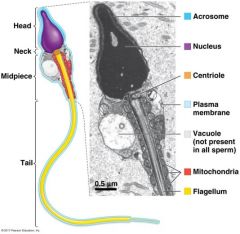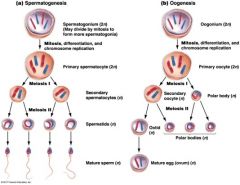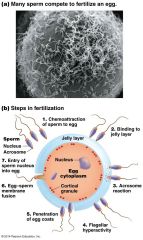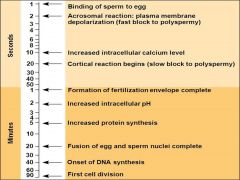![]()
![]()
![]()
Use LEFT and RIGHT arrow keys to navigate between flashcards;
Use UP and DOWN arrow keys to flip the card;
H to show hint;
A reads text to speech;
61 Cards in this Set
- Front
- Back
|
Preformation |
18th century account -preformation was the idea that an egg or sperm contained a miniture infant *a homunculus that grew isometrically during development |
|
|
Epigenesis |
-idea proposed by Aristotle (350bc) that an animal developes from a relatively formless egg *finally accepted in the 18th century |
|
|
5 essential cellular processes leading to orginism's development |
1. Cell division (proliferation) 2. Cell-cell interactions 3. cell differentiaion 4. cell movement and expansion 5. programed cell death |
|
|
Proliferation |
cell division
|
|
|
Apoptosis |
- programmed cell death
|
|
|
embryo |
An embryo is a multicellular diploid eukaryote in an early stage of embryogenesis, or development. In general, in organisms that reproduce sexually, an embryo develops from a zygote, the single cell resulting from the fertilization of the female egg cell by the male sperm cell. The zygote possesses half the DNA of each of its two parents.
|
|
|
Describe Cell division
|
cells have to proliferate (divide & make more cells) - for an individual to develop from undifferentiated mass of cells - location, timing & extent of these cell divisions are tightly controlled by cell-cycle checkpoints - mitosis: highly regulated 3 diff check pts to make sure it is occuring correctly |
|
|
How is cell division controlled?
|
Most cells stop dividing at maturity - some specialized, undifferentiated cells continue proliferating throughout the organisms life *Meristems: in plants areas of plant growth (produce stems, leaves, roots) * Stem Cells: in animals; divide to produce |
|
|
Stem Cells |
cell division control - Divide to produce 1. a daughter cell that remains a stem cell 2. Another daughter cell that differentiates into a specialized cell type 3. once after mitosis; daughter replaces itself & other cell goes on to what it is supposed to be |
|
|
Describe cell-cell interactions |
-during development, the most important cell-cell interactions involve sending/receiving signal - cell-cell signals change patterns of gene expression and are essential for changing cell activity during development *many cells are attached by membrane proteins |
|
|
Describe cell differentiation |
most cells must undergo differentiation in order to become a specialized type of cell - progressive, step-by-step process - cells are initially determined, or commited, to a specific developmental pathway and later become differentiated. *dev. is a progression- step-by-step, can't go back |
|
|
Differentiation |
In developmental biology, cellular differentiation is the process of a cell changing from one cell type to another. Most commonly this is a less specialized type becoming a more specialized type, such as during cell growth.
|
|
|
Describe cell movement & expansion |
animal cells have to move from normal dvelopment to occur: -During gastrulation, cells in diff parts of an early embryo rearrange themselves into 3 distinctive types of embryonic tissues...tissues...organs - plant cells do not move (cell wall), but changes in the orientation of cell division control the direction of susequent cell proliferation/expansion *cells comm. and move around usually during gastrilation *plants have rigid cell walls |
|
|
gastrulation |
Gastrulation is a phase early in the embryonic development of most animals, during which the single-layered blastula is reorganized into a trilaminar ("three-layered") structure known as the gastrula. These three germ layers are known as the ectoderm, mesoderm, and endoderm.
|
|
|
Morphogenesis |
Morphogenesis (from the Greek morphê shape and genesis creation, literally, "beginning of the shape") is the biological process that causes an organism to develop its shape. It is one of three fundamental aspects of developmental biology along with the control of cell growth and cellular differentiation.
|
|
|
describe Programmed cell death |
Apoptosis - carefully regulated aspect of normal development - abnormal apoptosis, either too much or too little, can lead to disease or deformation *in early dev. more neurons than we need *error- did not lead to death of the tissues |
|
|
Morphogen |
A morphogen is a substance governing the pattern of tissue development in the process of morphogenesis, and the positions of the various specialized cell types within a tissue. More specifically, a morphogen is a signaling molecule that acts directly on cells to produce specific cellular responses depending on its local concentration.
|
|
|
what is differential gene expression?
|
-expression of diff genes in dii cell types - key to cell differentiation during development -cells contain all of the same genes but express diff subsets *all cells have the same DNA- cells in skin, neurons, cheeks -same DNA just express diff genes |
|
|
Are differentiated cells genetically equivalent?
|
Plants: plant cells can de-differentiate to form other plant parts; branch can become roots (basil) - each cell must contain same genes required by all different types of plant parts (genetic equivalence *early exper's showed that transplanting nuclei from diploid frog cells into unfertilized eggs without nuclei resulted in dev of normal tadpoles *nuclear transfer experiments in sheep reinforced these results Cloning: all cells have necc. DNA to form all other cells |
|
|
describe animal Cloning |
Mammary gland cells from an adult sheep (clone) were fused with de-nucleated eggs -resulting embryos were implanted into surrogate mothers - a fertile, genetically identical Clone of the parent sheep was Dolly -Cloning provides evidence of genetic equivelence; differentiated cells contain all the genes in the genome |
|
|
Genetic equivelence |
concept that each cell in the body has the same genetic material and therefore all the information necessary to create a complete organism. Animal cloning from a somatic nucleus 'proves' this idea.
|
|
|
Research on cloning shows cellular differentiaion......
|
does not involve changes in genetic makeup of cells, but rather results from differential gene expression
|
|
|
how does the genetic material, DNA, in your body vary from cell to cell?
|
- ifferent genes are turned on and off but DO NOT VARY
|
|
|
Describe how chemical signals trigger differential gene expression?
|
Cell fate depends on: - timing (current stage of dev. of organisms) - spatial location(where it is in body or organism) Spatial location in early dev is determined by 3 body axes: 1. anterior-posterior 2. dorsa-ventral 3. left-right Cell dev and differentiation is dictated by each cell's location within the embryo |
|
|
what are the three body axes?
|
Spatial location in early dev is determined by 3 body axes: 1. anterior-posterior 2. dorsa-ventral3. left-right |
|
|
Understand Morphogens and how they work
|
Pattern Formation; series of events that determine an embryo's spactial organization - certain early signals act as Morphogens, setting up major body axes of the embryo *cells learn their position by sensing the concentration of a morphogen molecule * these morphogens activate a network of genes w/in cell |
|
|
what is the importance of the bicoid gene in the discovery of morphogens?
|
In fruit flies, the bicoid gene produces a morphogen that provides positional info -this signal tells cells where they are located along the anterior-posterior body axis (i.e presence leads to dev. of anterior structures) - a mutated bicoid gene results in production of a fly embryo with two tails and no head! |
|
|
what is the importance of AUXIN in plants? |
in plant embryo's, the cell-cell signal AUXIN enters cells & triggers production of transcription factors that affect differentiation. *like BICOID, Auxin works by forming concentration gradients; High concentration at top of embryo=stem ; low concetratiopn at bottom of embryo leads to root |
|
|
what is the importance of HOX genes and why are they important in understanding evolution?
|
*impt in regulation of body axis - controls segmented dev of animals - activate specific genes w/in each body segment, which cause the cells to produce specialized proteins and structures |
|
|
HOX genes and how they work
|
- mutations in hox genes cause body parts to appear in the wrong place. *proteins in hox genes signal body to do diff things *imp to do this because it tells us what certain Hox genes do in the body *Hox genes are homologous in animals (they are similar in all animals because they were present in a common ancestor) *although the Hox gene complex has been highly conserved, it can produce a wide diversity of animal morphology (as organisms become more complex, more hox genes) *if there is no gap. limbs will not dev. |
|
|
Why do snake limbs not form during development?
|
Hox genes overlap and are expressed together, no gap so no forelimns form
|
|
|
Sexual reproduction with____________ are _________ reproductive cells.
|
1. gametes 2. haploid M gametes= sperm F gametes= eggs |
|
|
Gametes |
a mature haploid male or female germ cell that is able to unite with another of the opposite sex in sexual reproduction to form a zygote.
|
|
|
How many genes are needed to make a baby? What are the ordered development phases through an animals life cycle? |
25,000 - Fertilization, Cleavage, Gastration, Neurulation & Organogenesis |
|
|
when does fertelization occur?
|
when a haploid sperm & egg cell fuse, forming a diploid Zygote (a fertalized egg)
|
|
|
Zygote |
A zygote, is a eukaryotic cell formed by a fertilization event between two gametes. The zygote's genome is a combination of the DNA in each gamete, and contains all of the genetic information necessary to form a new individual. In multicellular organisms, the zygote is the earliest developmental stage.
|
|
|
what are the 7 steps of fertilization?
|
1. sperm are drawn to the egg 2. head of sperm binds to jelly layer of egg 3. triggers acrosome reaction...sperm contents released 4. flagellar activity increases 5. sperm penetrates the egg coat 6. membrane fusion of sperm and egg 7. sperm nucleus enters egg |
|

|
|
|

|

|
|

|

|
|
|
what is the importance of Bindin in species recognition of sperm and eggs?
|
*helps sprem recognize the right egg -Protein on head of sea urchin sperm that binds to surface of sea urchin eggs -acts as "key", such that a sperm binds only to eggs of same species *Species-specific bindin molecules on sperm interact with species-specific receptors on egg surface (interaction is required for plasma membranes of sperm & egg to fuse) |
|
|
Why does only one sperm enter the EGG?
|
-animals employ different mechanisms to avoid polyspermy 2 mechanisms to block polyspermy (1)immedietly after contact (briefly effective, fast block) depolariztion (aka acrosomal reaction) *Ca2 based signal is rapidly introduced and propagated throughout the egg (2) physical barrier to sperm entry (slow block, aka cortical reaction) *Fertilization envelope; forms which keeps away additional sperm *In mammals, cortical granules release enzymes that modify egg-cell receptors, preventing binding by additional sperm |
|
|
What is cleavage? what results at the end of cleavage?
|
set of rapid cell divisions that take place in animal zygotes immediately after fertilization. *1st step in Embryogenesis (process that makes a single-celled zygote into a multicellular embryo) *partitions egg cytolplasm w/out any additional growth of zygote *cells created by cleavage divisions are called Blastomers *cleavage completes...embryo consists of hollow ball of blastomeres (blastula) |
|
|
Embryogenesis |
(process that makes a single-celled zygote into a multicellular embryo)
|
|
|
Organogenesis |
In animal development, organogenesis is the process by which the ectoderm, endoderm, and mesoderm develop into the internal organs of the organism. Internal organs initiate development in humans within the 3rd to 8th weeks in utero. The germ layers in organogenesis differ by three processes: folds, splits, and condensation.
|
|
|
Event 1 Cleavage |
*incomplete/meroblastic cleavage - non-avian/avian reptiles, elasmobranchs - eggs have large amout of yolk (yolk dense) -Vegetal pole- where yolk is more concentrated in the egg - Animal Pole: where there is less yolk and more cytoplasm in the egg *meroblastic cleavage-only this area undergoes cell division *forms disc called blastoderm |
|
|
Incomplete/meroblastic cleavage |

|
|
|
Event 2 Cleavage |
complete/holoblastic cleavage- amphibians, mammals - less yolk - cleavage during the 1st cell division is complete and bisects the entire zygote into two equal-sized blastomers (mammals undergo compaction creating a morula; blastocyst forms *mammalian blastula) |
|
|
Complete/Holoblastic cleavage |

|
|
|
Describe Mammalian Cleavage |
-egg in ovary - fertilization and cleavage occur in the oviduct *Blastocyst has a diff morphological appearance than the blastula/blastoderm embryos in non-mammalians *Blastocyst has: - outer epithelial layer Trophoblast that gives rise to Placenta -inner cell mass develops into embryo -embryo reaches uterus and hatches and is implanted in uterine wall |
|
|
Trophobalst |
occurs during mammalian cleavage -Blastocyst has this: outer epithelial layer that gives rise to the placenta |
|
|
What is the major end result of gastrulation?
|
Germ layer, gut, body axes - during this, extensive and highly organized cell movements radically rearrange embyotic cells into Gastrula *results in formation of the embryonic tissue layers Ectoderm, mesoderm and endoderm (GERM LAYERS)= gives rise to adult tissues and organs |
|
|
what is the process of gastrulation and how it occurs?
|
*blastula contains a fluid-filled Blastocoel *Gast begins with the formation of an opening called a blastopore *cells from peripher move inward through blastopore forming a tube-like structure that will become the gut (Archenteron) |
|
|
Archenteron |
forms during gastulation = gut -cells from peripher move inward through blastopore forming a tube-like structure that will become the gut (Archenteron) |
|
|
3 major outcomes of gastrulation?
|
- 3 embryonic tissues are arranged in layers - gut has formed - major body axes have become visible |
|
|
what is the process of organogenesis?
|
*process of tissue and organ formation * begins once gastrulation is complete and embrotic germ layers are in place *cells proliferate and become differentiated (become a specialized cell type) - differentiate cells have a distinctive structure and function because they express a distinctive suite of genes. |
|
|
What is the function of the notochord during neurulation?
|
Neurulation= embryonic process responsible for initiating CNS formation - Steps of neural tube formation *ectoderm overlaping notochord thickens (neutal crest)...neural grooves...two sides converge and fuse...neural tube closes |
|
|
steps of neurulation |
1. thickening and elongation: endoderm over the notochord thickens to form the neural plate, which elongates. Adjacent regions will form a neural crest and epidermis 2. Foldings: cells along the medial hinge point undergo apical constriction, causing the formation of the neural groove 3. Convergence: two dorsal lateral hinge points under go apical constriction to produce a tube like structure 4. Fusion: the dorsal nerve cells on either side of the neural tube begins to fuse, epidermis also fuses dorsel to the neural tube 5. Neural crest cells migrate away as fusion is complete |
|
|
|
|
|
|
what is the development and function of somites? |
*notochord that forms during neurulation functions as key organizing element during organogenesis - in many chordates, as orgonogenisis continues, the notochord cells undergo apoptosis *once neural tube forms, mesodermal cells become organized into blocks of tissues called somintes - they form on both sides of the neural tube down the length of the body |
|
|
Describe maturation and determination
|
-somite cells form a varity of structures - as somite matures: *somite cells become irreversibly determined *they will eventually differentiate into specific cell type based on their location of somite - in process of determination, somite cells differentiate in responce to signals from nearby tissues |

